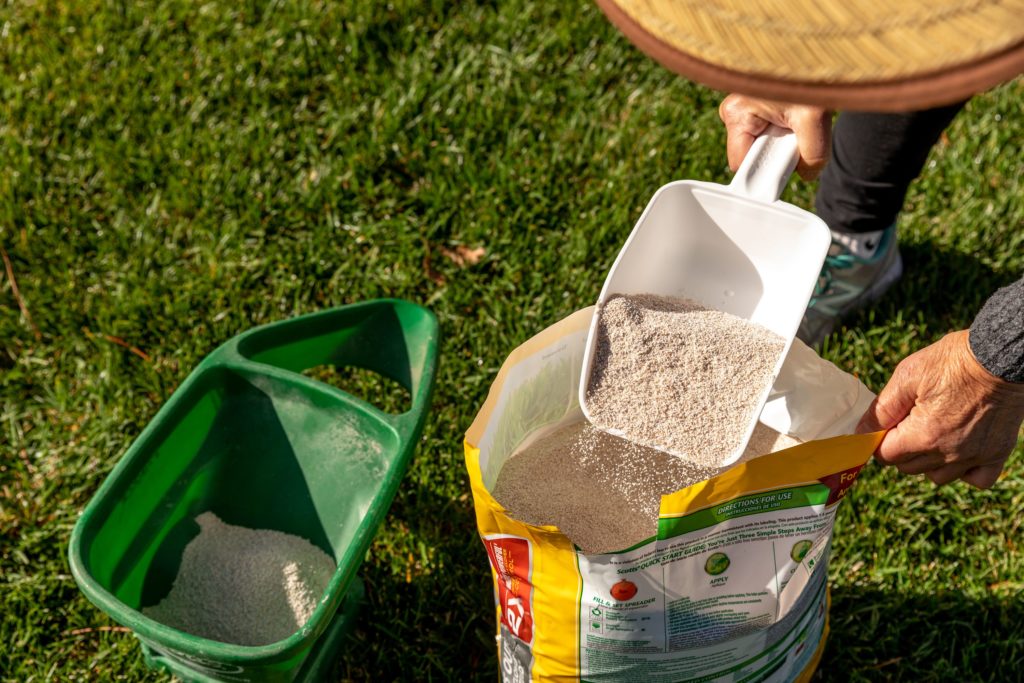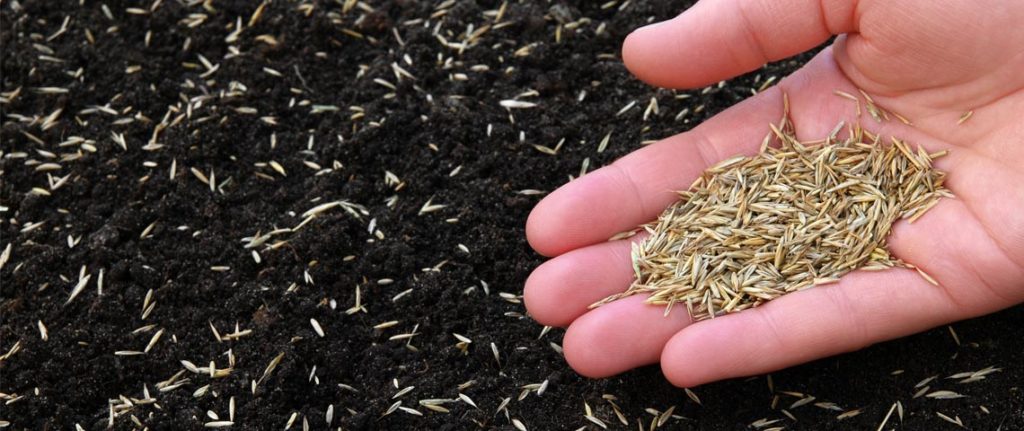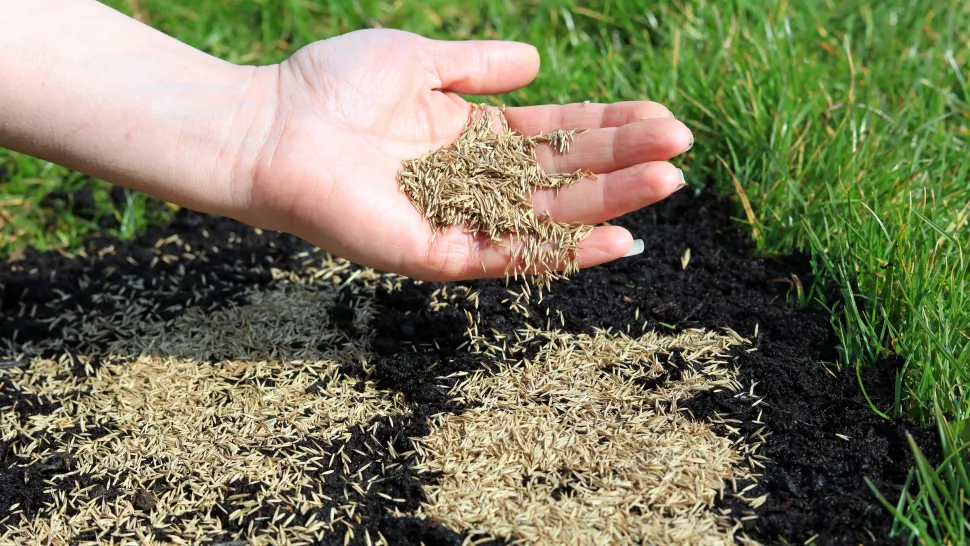The germination of seeds and the development of grass are commonly restricted by a shortage of nutrients in the soil environment. Apply the appropriate fertilizer and work it into the soil as soon as possible before planting grass seed in order to provide nutrients to the soil and prevent grass seed from burning up during germination.
With a good usage of fertilizer, you will have an equal spread of plant growth. Applying starter fertilizer while establishing a new lawn supplies nutrients to the sprouting grass stems needed to get going quickly. Increased phosphorus concentrations are found in starter fertilizers, which help to promote the development of strong, healthy roots.
Yes, you can put down grass seed and fertilizer together at the same time. You can follow these simple steps to combine the grass seed with fertilizer:
- Testing the Soil
- Selecting and applying a herbicide
- Preparing the area for reseeding
- Mixing seeds and fertilizer
- Applying the combined mixture
- Watering the area
After combining the grass seed with fertilizer you can apply this at the same time.
Applying fertilizer and seed simultaneously as seeding grass is not a good combination. This can result in an unequal distribution of the ingredients, resulting in patchy patches or seedlings burnt by an excessive amount of nitrogen fertilizer. Adding fertilizer to the soil before planting seedlings is essential.
Is It Better To Fertilize Or Plant Grass Seed First?

The major three components in fertilizers are nitrogen, phosphorus, and potassium. You can assess the percent of nutritional content in your chosen fertilizer by looking at the NPK value on the label. Nitrogen encourages the development and coloration of plants in a variety of ways.
When it comes to grass, phosphorus contributes to the formation of strong root systems as well as the prevention of fungal disease. Potassium helps in the production of photosynthesis. Almost all of these nutrients exhaust from the soil’s resources sooner. The gardeners are responsible for supplying these nutrients so that the grass can spread throughout the lawn.
- Start with a Fertilizer Application on Soil
Before you lay down your new lawn grass, fertilize the soil around it. You can use a rotary spreader to disperse about half the quantity of fertilizer required for your lawn by spreading it in a circular motion. Circularly move the spreader across the lawn in a clockwise direction.
Distribute the remaining fertilizer evenly throughout the lawn by sprinkling it vertically. To incorporate the fertilizer, till the top 2 to 4 inches of soil to a depth of 2 to 4 inches. Be careful to water the lawn after raking it to activate any fertilizer that may have become caught in the soil during the raking process.
- Start Planting Your Grass
Apply the fertilizer to your grass as soon as possible, after which you can spread the seeds in the ground. If you don’t seed your yard right away, weeds will take advantage of the nutrients in the bare ground. The process of seeding grass is essentially the same as that of fertilizing it. You should apply half the grass seeds vertically and the remaining horizontally.
Cut the grass seeds in halves using a knife. The kind of grass that you are growing will determine the amount of grass seeds that you need to purchase. For example, in order to cover 1,000 square feet with Bermuda grass, one pound of Bermuda grass should be distributed over 1,000 square feet. Then, water it after covering your seeds with 1/8 of an inch of compost.
Also Read: How to Make Fertilizer from Kitchen Waste? Step-by-Step Guide
How to Combine Grass Seeds with Fertilizer?

Before understanding how to mix grass seeds and fertilizer, it’s important to understand the many types of fertilizers that can be used on your lawn. Granular fertilizers, particularly when used in conjunction with grass seed, are highly recommended by most lawn care professionals.
This kind of fertilizer has a steady release, so it gradually adds nutrients to the ground over a period of time. As a result, a longer growing season is made possible because the grass is fed consistently with all of the essential nutrients it needs to thrive.
In addition, the mixture will speed the development of the grass on the lawn. Once the germination process is complete, the grass seed will have a lot of energy to burn off. Unfortunately, due to the potent mixture, you’ll also notice an increase in unwanted weed growth on your grass. Here is a list of steps to guide you on combining grass seed with fertilizer to achieve a lush, green lawn.
Step 1: Soil Testing
Soil testing is the first step in determining the best way to combine grass seeds and fertilizer simultaneously. This will necessitate the gathering of soil samples from various sites. The soil conditions in the reseeding area must also be taken into consideration. Send the soil to the local agricultural extension office, where it will be examined to determine its nutritional value.
For example, a soil test will assist you in determining what is wrong with your soil and how to correct the problem. It could take up to six weeks to test the soil and deliver the results. The laboratory can provide you with recommendations for the best fertilizer for your lawn based on the pH of the soil.
Step 2: Selecting and Applying a Herbicide
The presence of weeds on most lawns is a typical occurrence. Weeds come in a variety of shapes, sizes, and colors. The sort of weeds that you have in your yard will determine which herbicide you should use. There are many distinct sorts of weeds that can be discovered in a lawn, each with its characteristics. The most effective method is to use a powerful insecticide to eliminate them completely.
Step 3: Prepare The Area For Reseeding
When you’re finished with the dead thatches and other debris, scrape the dirt away with a garden rake to clear any remaining dirt. Before applying the fertilizer, use the garden rake to level and grade the soil. It will guarantee that the soil receives sufficient air circulation as an added benefit.
Before applying the final form of the mixture, you need to first remove the soil thatches and compost it. On the other hand, compost can be added at the end of the year since it is an organic material.
Step 4: Mixing Seeds and Fertilizer
Perhaps you already know how much fertilizer you should apply based on agricultural extension advice. The quality of your soil, the quality of your grass seeds, and the desired thickness of your lawn are all aspects to consider while you develop your lawn. Based on the variety, the amount of grass seed to be used per 1,000 square feet varies between 1 and 2 pounds. To complete the process, add the appropriate amount of fertilizer to your grass seed mixture. Then, thoroughly combine all of the ingredients in a big bucket or container.
Step 5: Applying the Combined Mixture
So you’ve successfully blended the two substances. Now is a good time to use them on the lawn area where you wish to re-establish grass growth. Avoid taking too much of the combo in one sitting. Instead, spread the grass and fertilizer mixture uniformly across the entire lawn in order to achieve the best possible growth results. A seed broadcaster can be used to spread the mixture quickly and evenly. It also helps in the prevention of problems associated with excessive thinning.
Step 6: Water the Area
As soon as the mixture has been administered, it is time to bring everything together. Afterward, you’ll need to soak the soil where the mixture will be applied before you can start working. You may administer water to your grass precisely by using a sprinkler and a garden hose.
Every week, a layer of one to two inches of water should be applied to the soil. Although it is unlikely, the amount of rainfall in your area could have a big effect. When the grass reaches 3.5 to 4 inches in height, it is time to mow it. It is possible to slice up to 2.5 inches thick.
How to Apply Lawn Seed and Fertilizer at the Same Time?

If you have a 25-square-foot lawn, it is recommended that you apply one-half pound of 5-10-5 starting fertilizer. Calculating the amount of fertilizer required for the total planting area is necessary. Set up a drop spreader near the planting area on a hard surface to distribute the fertilizer. Because you’ll be spreading the fertilizer in two equal chunks, drop the speeder’s speed to half of its typical setting before you start spreading. With the spreader, apply half of the fertilizer.
With a thin layer of fertilizer applied to the planting space in a corner, fertilize the area. As you progress through the site, move the drop spreader in horizontal rows throughout the full site as you progress through it. If you want to ensure even coverage, lay your spreader’s wheels on top of the outside wheel tracks of your previous rows.
Fill half of the drop spreader with the leftover fertilizer and set it aside. Then, starting from the exact corner where you left off, work your way around to the other side. Move the spreader back and forth across the planting area in vertical rows, covering all of the ground. The wheel tracks from the previous row should be placed on top of each other.
Rake the fertilizer into the top two to four inches of soil, working it in with your hands. Make long, even strokes with the rake on the soil to ensure fertilizer is well dispersed throughout. In order to smooth out the soil, sand it as best you can.
When planting grass, make sure you use the appropriate seeding rate for the type of grass you’re planting and stick to it. According to the pre-calculated rate, a weight of 1,000 pounds per square foot is applied. The amount of seeds required for your planting area is calculated by dividing the number of pounds of seeds by 1,000 and multiplying the result by the number of square feet of planting area.
Once you’ve determined how much seed you’ll need to cover the planting area, you may divide the total amount by two to get the total amount needed. The seeding rate of the drop spreader should be reduced to one-half of its typical setting. Fill the drop spreader with a single quantity of grass seed and sprinkle it throughout.
Extend the spreader across the planting area in vertical rows, with the spreader wheels crossing over each other in the outer wheel track. Fill the rest of the grass seed into the spreader as well. Spreader horizontal rows should be swept across planting locations.
To ensure that the seed is forced into the ground, roll a weighted roller back and forth over the planting spot in horizontal rows several times.
Topsoil should be applied to the planting area in an eighth- to a quarter-inch thickness. Water the top layer of soil and saturate it with moisture by applying a quarter-inch of water to it. Avoid washing the seeds away from the soil when irrigating your garden or lawn.
Frequently Asked Questions:
Grass seeds can be planted right away after fertilizer has been applied. However, the grass seeds will not germinate if the fertilizer contains a weed preventer. Therefore please check before applying.
The fertilizer should be used before sowing.
Planting fresh grass is best done in the spring or fall.
Before applying any weed and feed fertilizer, wait until your new grass is well-established. You’ve mowed it at least four times, typically 6 to 8 weeks, because most contain an herbicide that stops seed germination.
Conclusion
Grass, like all plants, needs regular attention to flourish. Proper care is necessary to ensure that you have a luscious green lawn. It is possible to obtain the best possible grass growth by appropriately mixing grass seeds and fertilizer. Grass seed fertilizer should have a high concentration of phosphate and nitrogen. If you properly combine fertilizer and grass seeds, you may be able to achieve a beautiful lawn.
